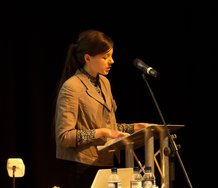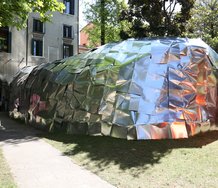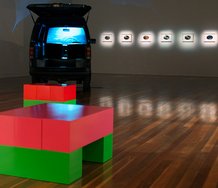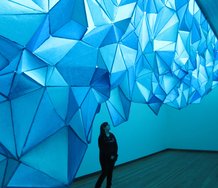Jodie Dalgleish – 5 June, 2010
As Straka commented during her floortalk at the Dunedin Public Art Gallery in April, her painted subject is selling something while she is never quite ‘had' by anyone. In her gaze and demeanour she remains an unattainable fantasy. Though claimed by painter after painter, she never takes a definite form: in some paintings her eyes are more rounded, her breasts more pointed, her finger more provocatively poised, her lips more dramatically painted, and her skin more lustrous.
Dunedin
Heather Straka
The Asian
Curated by Aaron Kreisler
20 March - 20 June 2010
When Dunedin-based artist Heather Straka was in Thailand last year she was thinking of ‘the copy’ - not just the endless so-called Gucci hand bags and Tag Heuer watches hawked on street corners, but the painted copy. Perhaps from the time of the Renaissance, the copy has generated its own kind of processes and market. Even though the Renaissance copy was concerned with expanding the school of a ‘master’, it established a role for the copyist and the copy and perhaps the connoisseur who could tell the difference between original and copy. Today, the Dafen village in the Shenzhen district of China is almost solely dedicated to the production of hand-painted copies of ‘old masterpieces’. These faux Da Vincis, Rubens, Rembrandts and all go out to casinos in the Mid-West of America, or some such establishment and place.
Straka’s latest artistic project The Asian puts fifty Dafen-produced and hand-painted copies of her own painting of a Shanghai poster girl wearing a tiki broach together with that original (The Asian, 2009). Installed at the Dunedin Public Art Gallery, all fifty-one paintings are hung on one wall in a kind of modernist grid that lures the viewer in to a search for the ‘original’ and the many seemingly significant differences between them. Straka painted The Asian while in Switzerland and sent it to Dafen to be copied. But after receiving the first ten copies, which all seemed to have been produced by the same artist, she decided to visit the village in person. With the help of a translator and with a digital copy of her painting in hand, Straka arranged for copies to be made and signed by fifty different artists. Then, before putting all of the paintings together in Dunedin, Straka signed The Asian under a pseudonym in Chinese characters.
In her installation, as in previous series of paintings, Straka’s irony unhinges stereotypes or assumptions that the act of painting or the tradition of art history might “pin down”, while, ironically, her painting practice makes a play for the role of the painter. Most obviously, The Asian presents copies in an art gallery where paintings are taken to be original, and, therefore, authentic.
It also makes Straka’s ‘original’ indistinguishable from its copies and the original hand of the copyist evident in the copy, engaging people in a mode of attention and investigation given to the most “valued” and “worthy” works of art. It also presents Chinese paintings of an originally Chinese image of a Western kind of ‘Shanghai Girl’, one whose image was used in marketing campaigns to sell Western products to the Chinese - for the Shanghai Girl is an exoticism of an exoticism, as is the tiki broach she wears. Also ironic, but not obvious, is the fact that Straka’s painting of The Asian is itself a copy of a painting she made in 2005, with tiki added.
Straka’s ability to leave her subject hanging is also seen in the repeatedly claimed yet ultimately unrealised identity of the Shanghai Girl. As she commented during her floortalk at the Dunedin Public Art Gallery in April, her painted subject is selling something while she is never quite ‘had’ by anyone. In her gaze and demeanour she remains an unattainable fantasy. Though claimed by painter after painter, she never takes a definite form: in some paintings her eyes are more rounded, her breasts more pointed, her finger more provocatively poised, her lips more dramatically painted, and her skin more lustrous. Ironically, her sexuality is up for grabs while it continually escapes depiction.
As the background to this, the colour palette of each painting constantly varies according to the set-up of the printer each copyist used to produce their outline of Straka’s work. Fundamentally, however, it is the unfamiliar yet culturally-charged tiki that becomes the most constant sign of the misrepresentation and reductionism the artist made evident in her ‘original’ painting and now the title of her exhibition.
As was particularly evident in the paintings she completed during her time as Frances Hodgkins fellow in Dunedin, Straka references a painting tradition that attempts to claim its models. Shown in The Sleeping Room at the Hocken in 2009, her paintings of anatomical samples held by the Otago Medical School, such as an eyeball trailing part of an optic nerve, drew a direct parallel between an anatomist and a painter. Alongside these, Straka presented portraits of her ‘body donor’ Amanda. In one painting Amanda is armless and in another she is identified by a tiny ear tag as a clone of herself. Yet she is always glowering, sexually ambiguous and apparently not “had” by any gaze.
It is perhaps most paradoxical that paintings of an armless woman and a delicate eyeball, for example, were given the careful painterly treatment expected of the painting tradition Straka seems to parody. In The Asian, the copy - inherently the antithesis of an original and, in turn, the aesthetic - is made an aesthetic object in which the hand of the copyist and the hand of the artist become one, freeing the painter to concern herself with painterly effects. Perhaps the ultimate irony of The Asian is that there is a kind of deception at work in the honest service of the artist as painter.
Jodie Dalgleish


 Advertising in this column
Advertising in this column Two Rooms presents a program of residencies and projects
Two Rooms presents a program of residencies and projects



This Discussion has 0 comments.
Comment
Participate
Register to Participate.
Sign in
Sign in to an existing account.